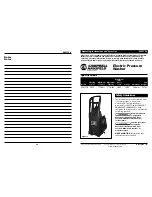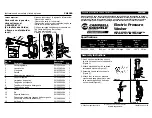
3
ENGLISH
•
Follow the guidelines below for preparing the wash load.
•
Read the
Operating Instructions
for operating your specific model.
•
Always read and follow fabric care and laundry product labels.
To reduce the risk of fire, electrical shock, or injury to persons, read
Important
Safety Instructions
before operating this washer.
1.
Sort laundry into loads that can be washed together.
Sort items by recommended water temperatures and wash time.
•
Separate white, light, and colorfast items from dark and noncolorfast items.
•
Separate items which shed lint from items which attract lint. Permanent press,
synthetic, knit and corduroy items will pick up lint from towels, rugs and chenille
bedspreads.
•
Separate heavily soiled items from lightly soiled items.
•
Separate lacy, sheer and loosely knit items from sturdy items.
•
Do not machine wash items containing fiberglass. Small particles of fiberglass left in
the drum may stick to fabrics in other loads and cause skin irritation.
2.
Prepare items for washing.
•
Empty pockets.
•
Brush off lint and dirt. Shake out rugs and beach towels.
•
Close zippers, fasten hooks, tie strings and sashes, and remove nonwashable trims and
ornaments.
•
Remove pins, decorative buttons, belt buckles, and other objects which could be
damaged. This also helps protect other items in the wash load.
•
Mend rips and tears to prevent further damage during washing.
•
Place delicate items such as bras, shoulder pads, hosiery, and belts in a mesh bag to
prevent tangling during the wash cycle.
•
Turn knit items inside out to prevent pilling.
3.
Pretreat stains and heavy soil.
See
Stain Removal
for details.
4.
Add laundry load to washer.
•
Combine large and small items in a load. Load large items first. Large items should not
be more than half the total wash load.
•
Washing single items such as a sweater, towel or jeans may cause an out-of-balance
load. Add 1 or 2 similar items to help balance the load.
•
Single heavy items such as a bedspread can be washed separately.
•
The washer can be fully loaded, but the items should not be tightly packed. The door
should close easily.
5.
Add detergent, bleach and fabric softener to automatic dispenser following
these steps:
A.
OPENING AND CLOSING THE DISPENSER DRAWER
•
Slowly open the dispenser drawer by first sliding the safety latch to the right,
then pulling the drawer out until it stops.
•
After adding laundry products, slowly close the dispenser drawer. Closing the
drawer too quickly could result in early dispensing of bleach or fabric softener.
Important Safety Instructions
Important Safety Instructions
Important Safety Instructions
Important Safety Instructions
Important Safety Instructions
(continued)
(continued)
(continued)
(continued)
(continued)
Avoid fire hazard or
electrical shock. Do not use an
adaptor plug or extension cord or
remove grounding prong from
electrical power cord. Failure to
follow this warning can cause
serious injury, fire or death.
CORRECT
Use this way ONLY
Do not use or mix
liquid chlorine bleach with other
household chemicals such as toilet
cleaners, rust removers, acid or
products containing ammonia. These
mixtures can produce dangerous
fumes which can cause serious injury
or death.
Note:
The instructions appearing in
this Owner's Guide are not meant to
cover every possible condition and
situation that may occur. Common
sense and caution must be practiced
when installing, operating and
maintaining any appliance.
Grounding type
wall receptacle
Power supply cord with 3-prong
grounding plug
Do not under any
circumstances, cut,
remove, or bypass the
grounding prong from
this plug.
Washing Procedures
Sort laundry into loads that can be washed
together.
Empty pockets.
Place delicate items in a mesh bag.
Add laundry load to washer.


























